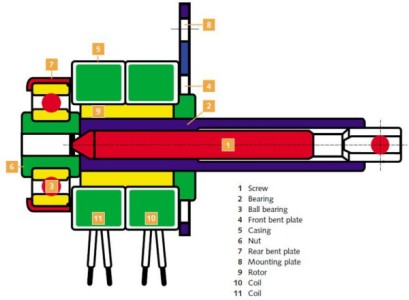Linear actuator description
Architectural schema
A linear actuator is an actuator that create movement along a straight line, in conflict with circular motion of electrical motor. The linear actuator is used in automation, automotive field (idle valve, light…), in valve and other field where is needed a linear movement. After a costructive schema of linear actuator:

The base of this construction is screw/nut system that permit the push and pull. The linear actuator is based on PM stepper motor, where the shaft is the screw. The internal part of rotor is machined for obtain a nut and one movement of rotor corresponding a lineam movement of screw. The “antirotation bearing” permit at the screw only the linear movement and not the rotative, for guarantee the precision. Force, precision and efficiency of actuator depends of screw pitch.
Link
Sonceboz hybrid linear actuator>>
Sonceboz linear actuator>>
